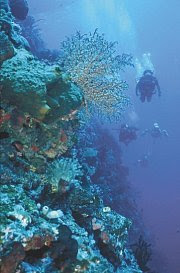
Bunaken National Marine Park is off the coast of North Sulawesi, Indonesia.
Bunaken is one of Indonesia's most famous dive/snorkeling areas, and it draws scuba divers & snorkelers from all over the world. In addition to Bunaken itself, a rather featureless banana-shaped island, the National Park includes the neighboring islands of Manado Tua, a distinctive cone-shaped extinct volcano, Siladen, Montehagen, Nain, and Nain Kecil.

The park is famed for the clarity of its water (35m visibility is common in the summer dry season), the abundance of coral and fish, and for the precipitous "walls" at some sites. Bunaken Timur, right off the east coast of the island and featuring all of the above, is according to some the best dive site in all Indonesia.
Except for the very largest pelagics, nearly everything can be found at Bunaken. Reef inhabitants include white and black tip reef sharks, giant sea turtles, napoleon fish, and dugongs.
You may frequently run into dolphins, and occasionally schools of whales.

Bunaken is barely a degree above the equator and thus tropical. The "Rainy Season" from November to mid April, brings frequent rains, sometimes in storms lasting for several days, which make the air nice and cool but also reduce visibility. The "Dry Season" from May to October, when temperatures climb to 35° and visibility reaches a maximum. Bunaken receives far less rain than the mainland and is well ventilated with sea breezes.
Bunaken is about 45-60 minutes by boat from Manado. Most resorts will arrange transfers from the airport for their guests. Alternatively, a public boat leaves daily except Sunday at 2-3PM from the canal on the north side of the market. The cost is 25,000Rp for tourists (7,000Rp for locals). It returns to Manado from the jetty in Bunaken village around 8-8:30AM every morning except Sunday. You can also charter a boat both ways at anytime.
As of September 2008, entry to the park costs either Rp 50,000/day or Rp 150,000/Calendar year. Even though the fee does not seem to be automatically levied upon entrance to the island, it is the responsibility of all visitors to the Park to have one, and most reputable dive shops will supply them. As proof of payment, you will receive a plastic tag that must be carried at all times — it's waterproof and can be attached to your diving gear.
Muddy paths connect the various settlements around the Bunaken. Many are effectively impassable after rain. Watch out if walking along the coastline, as the beach may disappear when the high tide rolls in.

Tourism on Bunaken has been very much geared towards divers over the years, but the trend seems to be changing and more and more snorkelers are visiting the area as too are those who wish to just relax immersed in nature...away from the hustle and bustle of city life. Possible activities for landlubbers include:
- Beach-combing, especially at low tide when the reef top is accessible
- Hiking to some of the secluded coves on the Eastern and Northern part of the island, but trails are poorly marked
- Fishing, but only outside of the park boundaries: hire a boat or join one of the local fishing boats.
- Dolphin & Whale watching, either while on diving or snorkeling boat trips or by hiring a boat.
The thing to do in Bunaken is dive, dive and dive! However, the steep walls and occasionally strong, rapidly changing currents mean that many sites cater more to the intermediate/advanced diver, although there are beginner-friendly sites too and all dive shops can arrange intro dives and Open Water Diver courses. The North Sulawesi Watersports Association offers oodles of detail on diving in the park. The park also offers outstanding snorkeling!
All dive shops in the park are affiliated with resorts, so see sleep below for listings.
The snorkeling is fantastic just in front of many of the resorts that surround the island, with an incredible amount of marine life living in the shallows and also on the outer walls.
Remember not to snorkel without fins as the currents can sometimes be strong, and change quickly even when they are not. Pick a reference point on the island and do not stray too far unless you are a confident swimmer.
from wikitravel.org
photo from official site of north-sulawesi.org





No comments:
Post a Comment